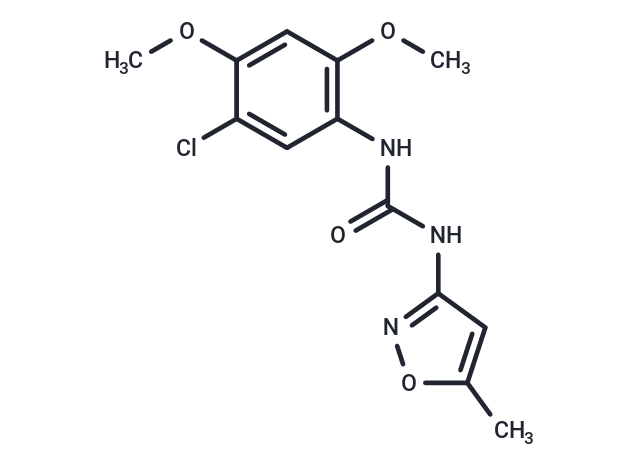购物车
- 全部删除
 您的购物车当前为空
您的购物车当前为空

PNU-120596 (NSC-216666) 是一种选择性α7 nAChR 阳性变构调节剂,EC50为 216 nM,可用于精神病和神经疾病的研究。


为众多的药物研发团队赋能,
让新药发现更简单!
PNU-120596 (NSC-216666) 是一种选择性α7 nAChR 阳性变构调节剂,EC50为 216 nM,可用于精神病和神经疾病的研究。
| 规格 | 价格 | 库存 | 数量 |
|---|---|---|---|
| 5 mg | ¥ 273 | 现货 | |
| 10 mg | ¥ 462 | 现货 | |
| 25 mg | ¥ 888 | 现货 | |
| 50 mg | ¥ 1,680 | 现货 | |
| 100 mg | ¥ 2,950 | 现货 | |
| 200 mg | ¥ 4,260 | 现货 | |
| 1 mL x 10 mM (in DMSO) | ¥ 273 | 现货 |
| 产品描述 | PNU-120596 (NSC-216666) is a positive allosteric modulator of α7 nAChR with EC50 of 216 nM. |
| 靶点活性 | α7 nAChR:NA |
| 体外活性 | PNU-120596通过增强由人类α7 nAChR工程变体介导的乙酰胆碱(Ach)激发的钙通量,以及通过野生型受体介导的乙酰胆碱和胆碱激发的电流,并在拟南芥卵母细胞中的激动剂持续存在时显著延长激发反应。PNU-120596能增加α7 nAChRs的通道平均开启时间,但对离子选择性无影响,对单位电导率的影响极小。当应用于急性海马切片时,PNU-120596增加了在锥体神经元中测量的ACh激发的GABAergic突触后电流的频率;该效果被TTX抑制,表明PNU-120596调节位于海马区星形细胞树突膜上的α7 nAChRs的功能。除了对α7 nAChR的正向调节外,PNU-120596还显著延缓了脱敏动力学,增加了通过过度刺激α7 nAChR引起的Ca2+诱导的毒性的潜力。PNU-120596还改变了与α7 nAChR结合时内部β折叶、转换区和激动剂结合位点的半胱氨酸可达性。PNU-120596的结合位点不在激动剂结合位点,并通过引起与由Ach促进的门控构象相似但非完全相同的构象效应来增强烟碱型受体激动剂激发的门控。 |
| 体内活性 | 系统性给药PNU-120596(1 mg/kg)给大鼠可改善由安非他明引起的听觉闸门缺陷,这一模型被提出用来反映与精神分裂症相关的电路级干扰。[1] 在卡拉胶之前给予PNU-1230596,30 mg/kg显著减轻了机械性痛觉过敏和承重缺陷,效果持续达4小时。PNU-120596减弱了由卡拉胶引起的TNF-α和IL-6在后爪水肿中的增加水平,而双氯芬酸仅减轻了IL-6水平。通过卡拉胶或CFA引起的已建立的机械性痛觉过敏也被PNU-120596部分逆转。[4] |
| 激酶实验 | Ca2+ Fluorescence Assay: SH-EP1 human epithelial cells expressing a variant of theα7 nAChR (α7*) are grown in minimal essential medium (MEM) containing nonessential amino acids supplemented with 10% fetal bovine serum, L-glutamine, 100 U/ml penicillin/streptomycin, 250 ng/mL fungizone, 400 μg/mL hygromycin B, and 800 μg/mL geneticin. α7* is a variant of the human α7 nAChR, with two point mutations in the first transmembrane domain (T230P and C241S) that allow for high functional expression in SH-EP1 cells [Groppi VE, Wolfe ML, Berkenpas MB (2003) U.S. Patent 6,693,172 B1]. Cells are grown in a 37 °C incubator with 6% CO2. Cells are trypsinized and plated in 96-well plates with dark side walls and clear bottoms at a density of 2 × 104 cells/well 2 days before analysis. Cells are loaded with a mixture of Calcium reen-1AM in anhydrous dimethylsulfoxide and 20% pluronic F-127. This reagent is added directly to the growth medium of each well to achieve a final concentration of 2 μM Calcium Green-1 AM. Cells are then incubated in the dye for 1 hour at 37 °C and then washed four times with Mark's modified Earle's balanced salt solution (MMEBSS) composed of the following (inmM): 4 CaCl2, 0.8 MgSO4, 20 NaCl, 5.3 KCl, 5.6 D-glucose, 20 Tris-HEPES, and 120 N-methyl-D-glucamine, pH 7.4. After the fourth cycle, the cells are allowed to incubate at 37 °C for at least 10 minutes. The final volume of MMEBSS in each well is 100 μL and atropine is added to all wells for a final concentration of 1 μM. A fluorometric imaging plate reader (FLIPR; Molecular Devices, Union City, CA) is set up to excite Calcium Green at 488 nm using 500 mW of power and reading fluorescence emission of >525 nm. A 0.5 seconds exposure is used to illuminate each well. Fluorescence is detected using an F-stop set of either 2.0 or 1.2. After 30 seconds of baseline recording, test compounds are added to each well of a 96-well plate in 50 μL of a 3 × stock.In each experiment, four wells are used as vehicle (0.2% DMSO) controls. |
| 细胞实验 | SH-SY5Y-α7 cells are plated on 96-well plates at a density of 15,000 cells per well (100 μL of 1.5 × 105 cells per mL) in complete growth medium and placed into a 37 °C incubator for 20 to 24 hours. Complete growth medium then is replaced with experimental medium alone ("PNU-120596 free") or containing appropriate concentrations of PNU-120596 and returns to the 37 °C ncubator for 20 to 24 hours. The medium is then replaced with fresh experimental medium and 20 μL per well MTS solution and returned to the 37 °C incubator for 3 hours, after which the plate is read on a microplate spectrophotometer at an absorbance of 490 nm. For all data analysis, data are normalized to untreated compound-free wells (100% cell viability) and a background absorbance taken from wells containing experimental medium and MTS solution.(Only for Reference) |
| 动物实验 | Animal Models: male Sprague Dawley rats (weighing 250–300 g)Formulation: PNU-120596 is dissolved in 5% DMSO and 5% Solutol in PBS.Dosages: 1 mg/kgAdministration: PNU-120596 is intravenously administrated 5 minutes before auditory gating measurements. |
| 别名 | NSC 216666 |
| 分子量 | 311.72 |
| 分子式 | C13H14ClN3O4 |
| CAS No. | 501925-31-1 |
| Smiles | COc1cc(OC)c(NC(=O)Nc2cc(C)on2)cc1Cl |
| 密度 | 1.403g/cm3 |
| 存储 | Powder: -20°C for 3 years | In solvent: -80°C for 1 year | Shipping with blue ice. | |||||||||||||||||||||||||||||||||||
| 溶解度信息 | DMSO: 31.2 mg/mL (100 mM) | |||||||||||||||||||||||||||||||||||
溶液配制表 | ||||||||||||||||||||||||||||||||||||
| ||||||||||||||||||||||||||||||||||||
评论内容